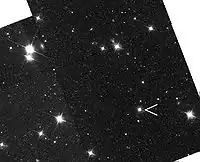PKS 2000-330
PKS 2000-330 (also known as QSO B2000-330) is a quasar[1] located in the constellation Sagittarius. When identified in 1982, it was the most distant and most luminous object known.[3]
| PKS 2000-330 | |
|---|---|
 Hubble Legacy Archive WFPC2 image of PKS 2000-330 | |
| Observation data (Epoch J2000) | |
| Constellation | Sagittarius |
| Right ascension | 20h 03m 24.116s[1] |
| Declination | −32° 51′ 45.13″[1] |
| Redshift | 3.773[2] 274,681 km/s[1] |
| Distance | 11.7 billion light-years (Light travel time)[2] 22.7 billion light-years (present)[2] |
| Type | Quasar[1] |
| Apparent magnitude (V) | 18.4 (SIMBAD)[1] 19.0 (NED)[2] 17.3 - 19.0[3] |
| Other designations | |
| 2MASS J20032410-3251452, QSO B2000-330[1] | |
| See also: Quasar, List of quasars | |
Distance measurements
The "distance" of a far away galaxy depends on what distance measurement you use. With a redshift of 3.77,[2] light from this active galaxy is estimated to have taken around 11.7 billion years to reach us.[2] But since this galaxy is receding from Earth at an estimated rate of 274,681 km/s[1] (the speed of light is 299,792 km/s), the present (co-moving) distance to this galaxy is estimated to be around 22.7 billion light-years (6947 Mpc).[2]
References
- "PKS 2000-330". SIMBAD. Centre de données astronomiques de Strasbourg. Retrieved 2010-04-28.
- "NASA/IPAC Extragalactic Database". Results for PKS 2000-330. Retrieved 2010-04-28.
- Peterson, B. A.; Savage, A.; Jauncey, D. L.; Wright, A. E. (1982). "PKS 2000-330 - A quasi-stellar radio source with a redshift of 3.78". Astrophysical Journal. 260: L27–L29. Bibcode:1982ApJ...260L..27P. doi:10.1086/183863.
External links
- Wikisky image of PKS 2000-330
This article is issued from Wikipedia. The text is licensed under Creative Commons - Attribution - Sharealike. Additional terms may apply for the media files.